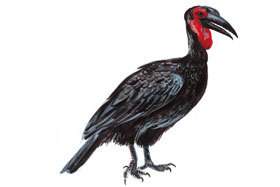
Northern Sandveld
 This complicated and diverse habitat is restricted to the far north of Kruger - around Punda Maria and west of the tar road to Pafuri with pockets along the north-eastern Lebombo. The Sandveld is characterised by sandy, well-drained soils which support a tangle of plant life. The vegetation is a curious mix of the lush Soutspansberg and the more arid Lebombo types as well as a good variety of bushwillows and acacias.
This complicated and diverse habitat is restricted to the far north of Kruger - around Punda Maria and west of the tar road to Pafuri with pockets along the north-eastern Lebombo. The Sandveld is characterised by sandy, well-drained soils which support a tangle of plant life. The vegetation is a curious mix of the lush Soutspansberg and the more arid Lebombo types as well as a good variety of bushwillows and acacias.
Characteristic trees of the Sandveld include the Pod-mahogany (Afzelia quanzensis), Nyala-tree (Xanthocercis zambesiaca), Southern Lala-palm (Hyphaene coriacea), Fever-tree (Acacia xanthophloea), tree Mopane (Colophospermum mopane), and of course, the mighty Baobab (Adansonia digitata).
The dramatic ridges that protrude from the lowveld floor are Clarens sandstone - they are particularly magnificent along the Luvuvhu River Valley. This area has elements of tropical African vegetation.
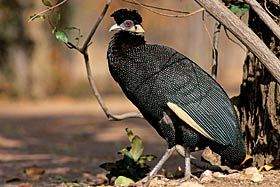 The Sandveld is the southernmost range of a number of tropical bird species such as the Böhm's Spinetail, which nests in the Baobabs scattered throughout northern Kruger. Because of the vegetation diversity and the tropical latitude, the Sandveld is renowned for its rarities such as the Crested Guineafowl, Purple Roller and Dickinson's Kestrel.
The Sandveld is the southernmost range of a number of tropical bird species such as the Böhm's Spinetail, which nests in the Baobabs scattered throughout northern Kruger. Because of the vegetation diversity and the tropical latitude, the Sandveld is renowned for its rarities such as the Crested Guineafowl, Purple Roller and Dickinson's Kestrel.
Mopaneveld
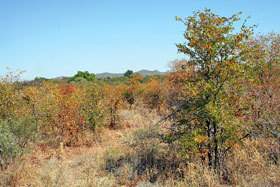 Mopaneveld is the most dominant ecosystem, covering over half the Park's surface area. It stretches northwards from the Timbavati and Olifants Rivers to the Limpopo.
Mopaneveld is the most dominant ecosystem, covering over half the Park's surface area. It stretches northwards from the Timbavati and Olifants Rivers to the Limpopo.
The name derives from the Mopane tree (Colophospermum mopane), which comprises three main habitats - Mopane woodlands (mostly the north-west), which are generally found on granite and gneiss; Mopane shrubveld (mostly the central northern plains and the north-east), which is associated with impervious basalt; and Mopane thickets (restricted to the Punda Maria area), which grow on ecca shales.
Within the mopaneveld there are other tree species - particularly the bushwillows like the Russet Bushwillow (Combretum hereroense), which is found on clay soils, Knob-thorn (Acacia nigrescens), and Apple-leaf (Philenoptera violacea) trees and shrubs with Tambotis (Spirostachys africana) and Leadwoods (Combretum imberbe) often found along the drainage lines.
The dry climate of the mopaneveld means that game densities are generally lower than the rest of Kruger. The shrub Mopane habitat cannot be described as a bountiful birding environment - particularly during the dry season - but the tree Mopane woodlands are a different story. The established Mopane forests around Punda and Pafuri Gate offer two of Kruger's most sought after rarities - Arnot's Chat and the Raquet-tailed Roller.
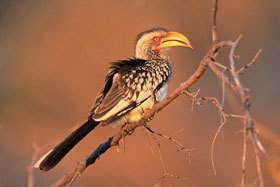 Where mopaneveld is found in association with other habitats - such as thorn veld or the alluvial plains around Shingwedzi - the birdlife gets much more interesting, especially in summer. The Yellow-billed Oxpecker is a South African rarity which may be seen with the herds of buffalo in the north.
Where mopaneveld is found in association with other habitats - such as thorn veld or the alluvial plains around Shingwedzi - the birdlife gets much more interesting, especially in summer. The Yellow-billed Oxpecker is a South African rarity which may be seen with the herds of buffalo in the north.
There are often good raptor sightings in grasslands within the mopaneveld, particularly of rarer species like Pallid and Montagu's Harriers. Many of the grassland species of the south, such as rollers and hornbills, are also found here.
Savanna Grassland
 The eastern sweetveld plains that stretch south from the Olifants River through Satara and Tshokwane and down to Lower Sabie are archetypal savanna grassland. They are home to large, grazing herds and their predators, as well as Kruger's biggest birds.
The eastern sweetveld plains that stretch south from the Olifants River through Satara and Tshokwane and down to Lower Sabie are archetypal savanna grassland. They are home to large, grazing herds and their predators, as well as Kruger's biggest birds.
The open veld has a variety of palatable grasses such as blue Buffalo grass (Cenchrus ciliaris), Finger grass (Digitaria eriantha) and Stinking grass (Bothriochloa radicans). There is a predominance of Knob-thorn Acacia (Acacia nigrescens) in tree and shrub form, Umbrella Acacia (Acacia tortilis), Marula (Sclerocarya birrea) and Red Bushwillow (Combretum apiculatum).
The open plains have dark, clay soils which are separated from the underpinning basalt by a layer of calcrete. This geological structure lends itself to water retention so that during the rainy season, vleis and pans form quite quickly along the drainage lines, which are the site of most birding activity. Birds are also attracted by the larger trees that grow along the watercourses. Raptors often use these as perches.
Game birds are plentiful in the grasslands, among them Shelley's Francolin, Coqui Francolin, and the Harlequin Quail. The grasslands also support Kruger's largest birds - the Common 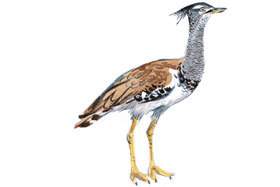 Ostrich*, Secretarybird and Kori Bustard. Many of South Africa's seed-eaters such as the Sabota and other larks, cisticolas and buntings are found here, as well as the more omnivorous Lilac-breasted Roller and the Magpie Shrike*.
Ostrich*, Secretarybird and Kori Bustard. Many of South Africa's seed-eaters such as the Sabota and other larks, cisticolas and buntings are found here, as well as the more omnivorous Lilac-breasted Roller and the Magpie Shrike*.
Mixed Broadleaf Woodland
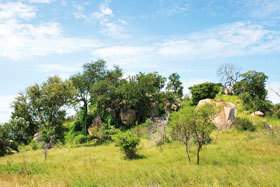 The mixed broadleaf woodlands dominate large tracts of central western Kruger and the rolling ridges south of Skukuza. The main trees are the bushwillow (Combretum) species - Red Bushwillow (Combretum apiculatum), Russet Bushwillow (Combretum hereroense), Large-fruited Bushwillow (Combretum zeyheri) and the Leadwood (Combretum imberbe) - as well as large Marulas (Sclerocarya birrea), Magic Guarri (Euclea divinorum), pockets of Knob-thorn Acacia (Acacia nigrescens) and Round-leaved Bloodwood (Pterocarpus rotundifolius), which is also known as teak.
The mixed broadleaf woodlands dominate large tracts of central western Kruger and the rolling ridges south of Skukuza. The main trees are the bushwillow (Combretum) species - Red Bushwillow (Combretum apiculatum), Russet Bushwillow (Combretum hereroense), Large-fruited Bushwillow (Combretum zeyheri) and the Leadwood (Combretum imberbe) - as well as large Marulas (Sclerocarya birrea), Magic Guarri (Euclea divinorum), pockets of Knob-thorn Acacia (Acacia nigrescens) and Round-leaved Bloodwood (Pterocarpus rotundifolius), which is also known as teak.
The mixed woodland landscape is one of low, rolling hills on a geological bed of granite and/or gneiss. The upper contours consist of coarse, sandy soils with mixed grasses, while the footslopes and valleys between these hills consist of clay soils which can support large specimens of Tamboti (Spirostachys Africana), Sycamore Fig (Ficus sycomorus) and Sausage-trees (Kigelia africana). Within this mixed woodland there are pockets of grazing that sometimes open up into extensive grasslands, particularly around pans. The sweeter grasses, and therefore also the grazing animals, generally occur on the lower contours.
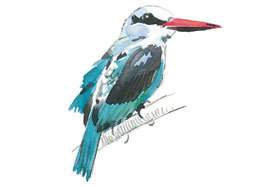 Birds well adapted to the mixed woodlands are hornbills, shrikes, francolins and smaller raptors. Where there is water one will find the cuckoos and kingfishers, as well as fruit-eaters such as the African Green-Pigeon. In denser pockets of woodland where the trees are over 6m tall and the crowns touch, one finds Woodland Kingfisher (in summer), African Grey Hornbill, Black-headed Oriole, Red-headed Weaver, Green Wood-Hoopoe* and African Scops-Owl. Raptors seek the taller woodland trees for nesting.
Birds well adapted to the mixed woodlands are hornbills, shrikes, francolins and smaller raptors. Where there is water one will find the cuckoos and kingfishers, as well as fruit-eaters such as the African Green-Pigeon. In denser pockets of woodland where the trees are over 6m tall and the crowns touch, one finds Woodland Kingfisher (in summer), African Grey Hornbill, Black-headed Oriole, Red-headed Weaver, Green Wood-Hoopoe* and African Scops-Owl. Raptors seek the taller woodland trees for nesting.
Thornveld
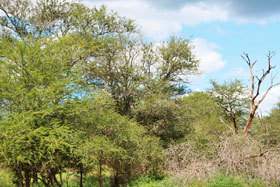 Within the mixed broadleaf woodlands and along the Sabie and Crocodile River catchment areas are extensive thorn thickets. These can be almost impenetrable in some areas and are the favoured habitat of the rare black rhino.
Within the mixed broadleaf woodlands and along the Sabie and Crocodile River catchment areas are extensive thorn thickets. These can be almost impenetrable in some areas and are the favoured habitat of the rare black rhino.
The thorn thickets consist mostly of acacias - particularly the Delagoa (Acacia welwitschii), Knob-thorn (Acacia nigrescens), Scented-pod (Acacia nilotica), Umbrella (Acacia tortilis) and Robust (Acacia robusta) Acacias. Within the thorny tangle of acacias are Small-leaved Sickle-bush (Dichrostachys cinerea), Magic Guarri (Euclea diviorum) and Buffalo-thorn Jujube (Ziziphus mucronata) known in Afrikaans as Blinkblaar-wag-'n-bietjie (wait a bit because of the time it takes to extract oneself from the thorns if one is unlucky enough to get tangled up in this tree).
These thickets are dominant in the catchment areas of the south but are found in patches throughout Kruger. Thornveld seems to do especially well in places where the underlying geology consists of shale, gabbro or gneiss. The acacias in particular support a rich and complex insect life  and therefore attract lots of insect-eaters such as rollers, shrikes and hornbills. Seeds from the Umbrella Acacia provide an important part of the diet of the noisy Brown-headed Parrots.
and therefore attract lots of insect-eaters such as rollers, shrikes and hornbills. Seeds from the Umbrella Acacia provide an important part of the diet of the noisy Brown-headed Parrots.
Lebombo
The dry and rugged Lebombo range forms the eastern border of Kruger. The smallish, scattered rocks are mostly rhyolite, which gives the hills their distinctly pinkish hue.
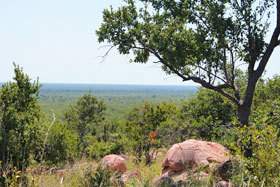 The soils of the Lebombo are shallow and stony, and as this is one of the driest parts of Kruger it is dominated by drought-resistant plants such as succulents and euphorbias - particularly the Deadliest Euphorbia (Euphorbia cooperi), which has a highly poisonous latex.
The soils of the Lebombo are shallow and stony, and as this is one of the driest parts of Kruger it is dominated by drought-resistant plants such as succulents and euphorbias - particularly the Deadliest Euphorbia (Euphorbia cooperi), which has a highly poisonous latex.
White Kirkia (Kirkia acuminata), thickets of Lebombo-ironwood (Androstachys johnsonii) and Large-leaved Rock Figs (Ficus abutilifolia) are found on the hill crests, while the lower slopes have Knob-thorn (Acacia nigrescens), Silver and Giant Raisin bushes (Grewia species), Purple-pod Cluster-leafs (Terminalia prunioides) and the ubiquitous bushwillow species. Marulas (Sclerocarya birrea) and Round-leaved Bloodwood (Pterocarpus rotundifolius) mark the transition to the basalt flatlands.
In places there are marshy vleis around the base of the Lebombo formed by water run-off. One of the best examples of such a wetland is at the large vlei area at the base of Muntshe Hill.
Bird species associated with the Lebombo are a mixture of coastal birds and those often associated with the more arid areas of southern Africa such as the Mocking Cliff-Chat and Cinnamon-breasted Bunting*. When in flower, the aloes and euphorbias attract many sunbird species. The raptors seen over the Lebombo include the Black-chested Snake-Eagle and the Bateleur, while the Freckled Nightjar is a common night bird.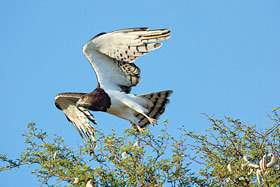
South-western Foothills
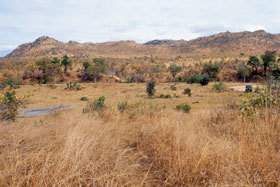 These fall within the 'rain face' of the escarpment and therefore enjoy the highest rainfall in the Park. The foothills often take the shape of dramatic granite outcrops, particularly around Pretoriuskop in the west and Berg-en-Dal and Malelane in the south.
These fall within the 'rain face' of the escarpment and therefore enjoy the highest rainfall in the Park. The foothills often take the shape of dramatic granite outcrops, particularly around Pretoriuskop in the west and Berg-en-Dal and Malelane in the south.
The vegetation is mostly mixed woodland with sour and fibrous grasses such as Fine Thatching grass (Hyparrhenia filipendula) and Yellow Thatching grass (Hyparrhenia dissoluta). Trees particularly associated with the Pretoriuskop area are Silver Cluster-leaf (Terminalia sericea), Kiaat Bloodwood (Pterocarpus angolensis) and Marula (Sclerocarya birrea) while the Berg-en-Dal area has most of the broadleaf woodland trees such as the bushwillow species and Magic Guarri (Euclea divinorum).
There are Large-leaved Rock Figs (Ficus abutilifolia) and Mountain Kirkia (Kirkia wilmsii) among the rocky outcrops, and the Sacred Coral-tree (Erythrina lysistemon). The grazing becomes sweeter as the altitude drops and the soils become less sandy and more clay-based, especially along the contour lines where Sycamore Figs (Ficus sycomorus), Tamboti (Spirostachys africana), and Ebony Jackal-berry (Diospyros mespiliformis) thrive. There are often thorn thickets along watercourses in the area - Scented-pod Acacia (Acacia nilotica) and Sickle-bush (Dichrostachys cinerea) are dominant.
 The high rainfall enjoyed by the south-west has resulted in many rare plant species and most of the drives in this habitat offer wonderful views over the lowveld. The birding is generally better around Berg-en-Dal than Pretoriuskop.
The high rainfall enjoyed by the south-west has resulted in many rare plant species and most of the drives in this habitat offer wonderful views over the lowveld. The birding is generally better around Berg-en-Dal than Pretoriuskop.
Birds that are found in the south-western foothills include many of the smaller raptors such as the African Cuckoo Hawk, occasionally the African Crowned Eagle and very rarely the Jackal Buzzard. Other birds that favour the higher altitudes of the south-west are the Red-winged Starling, Cinnamon-breasted Bunting* and the Mocking Cliff-Chat*.
Riverine Forest
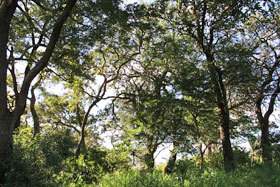 The best birding in Kruger is generally found along the main watercourses where established riverine forests are dominated by large trees such as the Sycamore Fig (Ficus sycomorus), Leadwood (Combretum imberbe), Ebony Jackal-berry (Diospyros mespiliformis), Natal-mahogany (Trichilia emetica), Tamboti (Spirostachys africana), Weeping Boer-bean (Schotia brachypetala) which is more common south of the Sabie River, Sausage-tree (Kigelia africana), Apple-leaf (Philenoptera violacea) and Nyala-tree (Xanthocercis zambesiaca). These trees have interlocking crowns and the ground below is dominated by shrubs and creepers at the expense of grass.
The best birding in Kruger is generally found along the main watercourses where established riverine forests are dominated by large trees such as the Sycamore Fig (Ficus sycomorus), Leadwood (Combretum imberbe), Ebony Jackal-berry (Diospyros mespiliformis), Natal-mahogany (Trichilia emetica), Tamboti (Spirostachys africana), Weeping Boer-bean (Schotia brachypetala) which is more common south of the Sabie River, Sausage-tree (Kigelia africana), Apple-leaf (Philenoptera violacea) and Nyala-tree (Xanthocercis zambesiaca). These trees have interlocking crowns and the ground below is dominated by shrubs and creepers at the expense of grass.
Riverine forests occur in varying degrees of intensity along all seven major rivers which bisect the Park - the Limpopo, Luvuvhu, Shingwedzi, Letaba, Olifants, Sabie and Crocodile Rivers. In addition, riverine bush is found on the banks of major seasonal rivers such as the Timbavati, the N'waswitsontso and the Biyamiti Rivers. In the south, there are often Wild Date-palms (Phoenix reclinata) within riverine bush, while in the north the Southern Lala-palm (Hyphaene natalensis) is more dominant.
The best examples of riverine forest are in the alluvial floodplains along the Sabie, Shingwedzi, Luvuvhu and Limpopo Rivers. This is because successive flood dumping has led to deeper soils which are more favourable to forest development. North of the Shingwedzi the Ana-tree (Faidherbia albida) and Nyala-trees are common, and there are extensive Fever-tree (Acacia xanthophloea) forests in the riverine woodland along the Luvuvhu and Limpopo watercourses.
 Birds typical of riverine forest include African Green-Pigeon, Purple-crested Turaco*, Trumpeter Hornbill and Great-spotted Cuckoo. In the denser understories, look out for Narina Trogon, White-browed Robin-Chat* and the African Paradise-Flycatcher. The African Fish-Eagle nests in riverine trees.
Birds typical of riverine forest include African Green-Pigeon, Purple-crested Turaco*, Trumpeter Hornbill and Great-spotted Cuckoo. In the denser understories, look out for Narina Trogon, White-browed Robin-Chat* and the African Paradise-Flycatcher. The African Fish-Eagle nests in riverine trees.
Each river has its own personality and acts as a habitat corridor between the escarpment and the coast. This means that birds not traditionally found in Kruger may be seen along the river systems. For instance, the range of eastern coastal birds extends far westwards along the rivers. Among them are the White-fronted Plover, Thick-billed Weaver, and even the odd Pelican or Grey-headed Gull.
Rivers play an important role in Kruger's birdlife. There are two main river systems that contain the Park - the Limpopo in the north and the Crocodile in the south. Growing agricultural and industrial demand for water upstream of Kruger has led to many rivers running dry. Only the Sabie and Crocodile rivers regularly flow all year round.
Hornbills as habitat indicators
Hornbills (Order Coraciiformes and Family Bucerotidae) are found throughout the Park. They are a good example of species adaptation to different habitats. To a limited extent they can be seen as habitat indicators with different types of hornbills occupying different but often overlapping ecozones.
 The most common hornbill in Kruger is the Southern Yellow-billed Hornbill (Tockus leucomelas), which is found mostly in the southern and eastern sweetveld and is associated closely with Knob-thorn savanna.
The most common hornbill in Kruger is the Southern Yellow-billed Hornbill (Tockus leucomelas), which is found mostly in the southern and eastern sweetveld and is associated closely with Knob-thorn savanna.
The African Grey Hornbill (Tockus nasutus) favours the sourveld woodlands, but when these trees lose their leaves in winter it departs to more reliable food sources to the north and east - either in farmlands adjoining the Park or higher up the escarpment.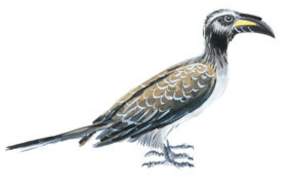
The Red-billed Hornbill (Tockus erythrorhynchus) is very common in the drier central and northern grasslands. Its presence usually means there is plenty of game around b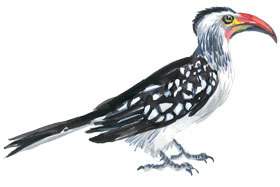 ecause it finds much of its food by digging in the dung of grazing animals. It appears to thrive in areas that have been overgrazed.
ecause it finds much of its food by digging in the dung of grazing animals. It appears to thrive in areas that have been overgrazed.
The Crowned Hornbill (Tockus alboterminatus) is very habitat specific, sticking only to the moist, heavily wooded areas. It is an uncommon resident that can sometimes be seen in the thicker bush around Skukuza, Shingwedzi, Punda and Pafuri.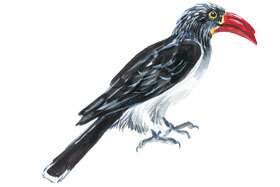
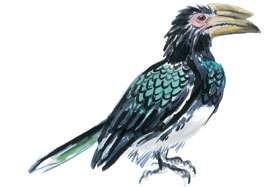
The Trumpeter Hornbill (Bycanistes bucinator) restricts itself to riverine forest where there are tall trees. It is most associated with the Levuvhu River area although its presence has also been recorded on the Olifants, Sabie and Crocodile Rivers.
The Southern Ground-Hornbill is a large bird found in lightly wooded grasslands throughout Kruger. It has been classified as an endangered species and has virtually disappeared from areas inhabitated by humans. It is usually found in flocks of up to six birds, walking around the veld feeding on anything from snakes to insects.